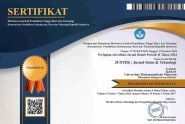Green Synthesis AgNPs menggunakan Bioreduktor Alami Ekstrak Buah Kiwi: Biosintesis, dan Karakterisasi
Abstract
Abstract: Green Synthesis or Green Chemistry of silver nanoparticles (AgNPs) has many advantages, one of which is fast, easy, and cheap. AgNPs have many benefits in the health sector. AgNPs are of great interest in the field of nanoparticle development because they have good biomedical and anti-bacterial activities. Bioreductors play an important role in reducing the size of AgNPs, in this study a natural bioreductor in the form of Kiwi extract (Actinida deliciosa) was used. Purpose of the study the objective of this research was the biosynthesis of AgNPs using a kiwifruit extract bioreductor. Research methods with extraction of Kiwi, synthesis of AgNPs using Kiwi extract, characterization of AgNPs formed using UV-Visible spectroscopy (UV-Vis), Fourier-transform Infrared Spectroscopy (FTIR), and Particle Size Analyzer (PSA). Research Results that AgNP formation was confirmed by optical performance using UV-VIS spectroscopy and showed an AgNP peak at 415 nm. The C-H, C-N, and C=O groups in Actinidia deliciosa were confirmed by FTIR. The size of the AgNPs was studied using PSA and a size of 65.01 nm was obtained.
Abstrak: Sintesis Hijau atau Kimia Hijau nanopartikel perak (AgNPs) memiliki banyak keuntungan, salah satunya cepat, mudah, dan murah. AgNPs memiliki banyak manfaat dalam bidang kesehatan. AgNPs menjadi perhatian besar dalam bidang pengembangan nanopartikel karena memiliki aktivitas biomedis dan anti bakteri yang baik. Bioreduktor memegang peran penting dalam mereduksi ukuran AgNPs, dalam penelitian ini digunakan bioreduktor alami berupa ekstrak Kiwi (Actinida deliciosa). Tujuan penelitian ini adalah biosintesis AgNPs menggunakan bioreduktor ekstrak buah Kiwi. Metode penelitian dengan esktraksi Kiwi, sintesis AgNPs menggunakan ekstrak Kiwi, karakterisasi AgNPs yang terbentuk menggunakan instrumen spektroskopi UV-Visible (UV-Vis), Fourier-transform Infrared Spectroscopy (FTIR), dan Particle Size Analyzer (PSA). Hasil Penelitian bahwa pembentukan AgNPs dikonfirmasi oleh kinerja optik menggunakan spektroskopi UV-VIS dan menunjukkan puncak AgNP pada 415 nm. Gugus C-H, C-N, dan C=O pada Actinidia deliciosa dikonfirmasi oleh FTIR. Ukuran AgNPs dipelajari menggunakan PSA dan diperoleh ukuran 65,01 nm.
Full Text:
PDFReferences
Chen, S., Marcelis, L. F. M., & Heuvelink, E. (2022). Far-red radiation increases flower and fruit abortion in sweet pepper (Capsicum annuum L.). Scientia Horticulturae, 305(January), 111386. https://doi.org/10.1016/j.scienta.2022.111386
Cinelli, M., Coles, S. R., Nadagouda, M. N., Błaszczyński, J., Słowiński, R., Varma, R. S., & Kirwan, K. (2017). Robustness analysis of a green chemistry-based model for the classification of silver nanoparticles synthesis processes. Journal of Cleaner Production, 162, 938–948. https://doi.org/10.1016/j.jclepro.2017.06.113
Esmaeilian, Y., Amiri, M. B., Tavassoli, A., Caballero-Calvo, A., & Rodrigo-Comino, J. (2022). Replacing chemical fertilizers with organic and biological ones in transition to organic farming systems in saffron (Crocus sativus) cultivation. Chemosphere, 307(June). https://doi.org/10.1016/j.chemosphere.2022.135537
Ghosh, S., & Mondal, A. (2020). Aggregation chemistry of green silver nanoparticles for sensing of Hg2+ and Cd2+ ions. Colloids and Surfaces A: Physicochemical and Engineering Aspects, 605(May), 125335. https://doi.org/10.1016/j.colsurfa.2020.125335
Guleria, G., Thakur, S., Shandilya, M., Kumar, S., Kumari, P., Sharma, D. K., & Thakur, S. (2022). Synthesis of α-Fe2O3/ethyl cellulose-based nanocomposites to extend the shelf-life of Capsicum annuum L. var. grossum. Materials Today: Proceedings, xxxx. https://doi.org/10.1016/j.matpr.2022.09.222
Harsini, M., Fitriany, E., Farida, A. N., Suryaningrum, D., Asy’ari, D. N., Widyaningrum, B. A., Paramita, D. R. A., Baktir, A., & Kurniawan, F. (2021). Polymelamine/gold nanoparticle-modified carbon paste electrode as voltammetric sensor of uric acid. Malaysian Journal of Analytical Sciences, 25(2), 286–295.
HARSINI, M., WIDYANINGRUM, B. A., FITRIANY, E., AYUPARAMITA, D. R., FARIDA, A. N., FARIDA, A., KURNIAWAN, F., & WIBAWASAKTI, S. C. (2022). Electrochemical synthesis of polymelamine/gold nanoparticle modified carbon paste electrode as voltammetric sensor of dopamine. Chinese Journal of Analytical Chemistry, 50(4), 100052. https://doi.org/10.1016/j.cjac.2022.100052
Hitesh, & Lata, S. (2018). Green Chemistry Based Synthesis of Silver Nanoparticles from Floral Extract of Nelumbo Nucifera. Materials Today: Proceedings, 5(2), 6227–6233. https://doi.org/10.1016/j.matpr.2017.12.231
Kalwar, K., & Shan, D. (2018). Antimicrobial effect of silver nanoparticles (AgNPs) and their mechanism – A mini review. Micro and Nano Letters, 13(3), 277–280. https://doi.org/10.1049/mnl.2017.0648
Magaña-López, E., Palos-Barba, V., Zuverza-Mena, N., Vázquez-Hernández, M. C., White, J. C., Nava-Mendoza, R., Feregrino-Pérez, A. A., Torres-Pacheco, I., & Guevara-González, R. G. (2022). Nanostructured mesoporous silica materials induce hormesis on chili pepper (Capsicum annuum L.) under greenhouse conditions. Heliyon, 8(3). https://doi.org/10.1016/j.heliyon.2022.e09049
Mir, T. ul G., Wani, A. K., Singh, J., & Shukla, S. (2022). Therapeutic application and toxicity associated with Crocus sativus (saffron) and its phytochemicals. Pharmacological Research - Modern Chinese Medicine, 4(June), 100136. https://doi.org/10.1016/j.prmcm.2022.100136
Naim, N., Ennahli, N., Hanine, H., Lahlali, R., Tahiri, A., Fauconnier, M. L., Madani, I., & Ennahli, S. (2022). ATR-FTIR spectroscopy combined with DNA barcoding and GC-MS to assess the quality and purity of saffron (Crocus sativus L.). Vibrational Spectroscopy, 123(September), 103446. https://doi.org/10.1016/j.vibspec.2022.103446
Nasiri, J., Rahimi, M., Hamezadeh, Z., Motamedi, E., & Naghavi, M. R. (2018). Fulfillment of green chemistry for synthesis of silver nanoparticles using root and leaf extracts of Ferula persica: Solid-state route vs. solution-phase method. Journal of Cleaner Production, 192, 514–530. https://doi.org/10.1016/j.jclepro.2018.04.218
Nie, J., Yang, J., Liu, C., Li, C., Shao, S., Yao, C., Chen, B., Tao, Y., Wang, F., Zhang, Y., Rogers, K. M., Wang, P., & Yuan, Y. (2023). Stable isotope and elemental profiles determine geographical origin of saffron from China and Iran. Food Chemistry, 405(PA), 134733. https://doi.org/10.1016/j.foodchem.2022.134733
Sajjad, M., Ahmad, F., Ali Shah, L., & Khan, M. (2022). Designing graphene oxide/silver nanoparticles based nanocomposites by energy efficient green chemistry approach and their physicochemical characterization. Materials Science and Engineering B: Solid-State Materials for Advanced Technology, 284(February), 115899. https://doi.org/10.1016/j.mseb.2022.115899
Shahid-ul-Islam, Butola, B. S., & Kumar, A. (2020). Green chemistry based in-situ synthesis of silver nanoparticles for multifunctional finishing of chitosan polysaccharide modified cellulosic textile substrate. International Journal of Biological Macromolecules, 152, 1135–1145. https://doi.org/10.1016/j.ijbiomac.2019.10.202
Vaid, P., Raizada, P., Saini, A. K., & Saini, R. V. (2020). Biogenic silver, gold and copper nanoparticles - A sustainable green chemistry approach for cancer therapy. Sustainable Chemistry and Pharmacy, 16(March), 100247. https://doi.org/10.1016/j.scp.2020.100247
Waqas, M., Ahmed, D., & Qamar, M. T. (2022). Surfactant-mediated extraction of capsaicin from Capsicum annuum L. fruit in various solvents. Heliyon, 8(8), e10273. https://doi.org/10.1016/j.heliyon.2022.e10273
Wen, C., Yin, A., & Dai, W. L. (2014). Recent advances in silver-based heterogeneous catalysts for green chemistry processes. Applied Catalysis B: Environmental, 160–161(1), 730–741. https://doi.org/10.1016/j.apcatb.2014.06.016
Zhu, X., Blanco, E., Bhatti, M., & Borrion, A. (2020). Jo ur na l P re of. Science of the Total Environment, 143747. https://doi.org/10.1016/j.foodcont.2022.109554
DOI: https://doi.org/10.31764/justek.v6i1.13918
Refbacks
- There are currently no refbacks.
JUSTEK : Jurnal Sains dan Teknologi sudah terindeks
EDITORIAL OFFICE:












.JPG)

